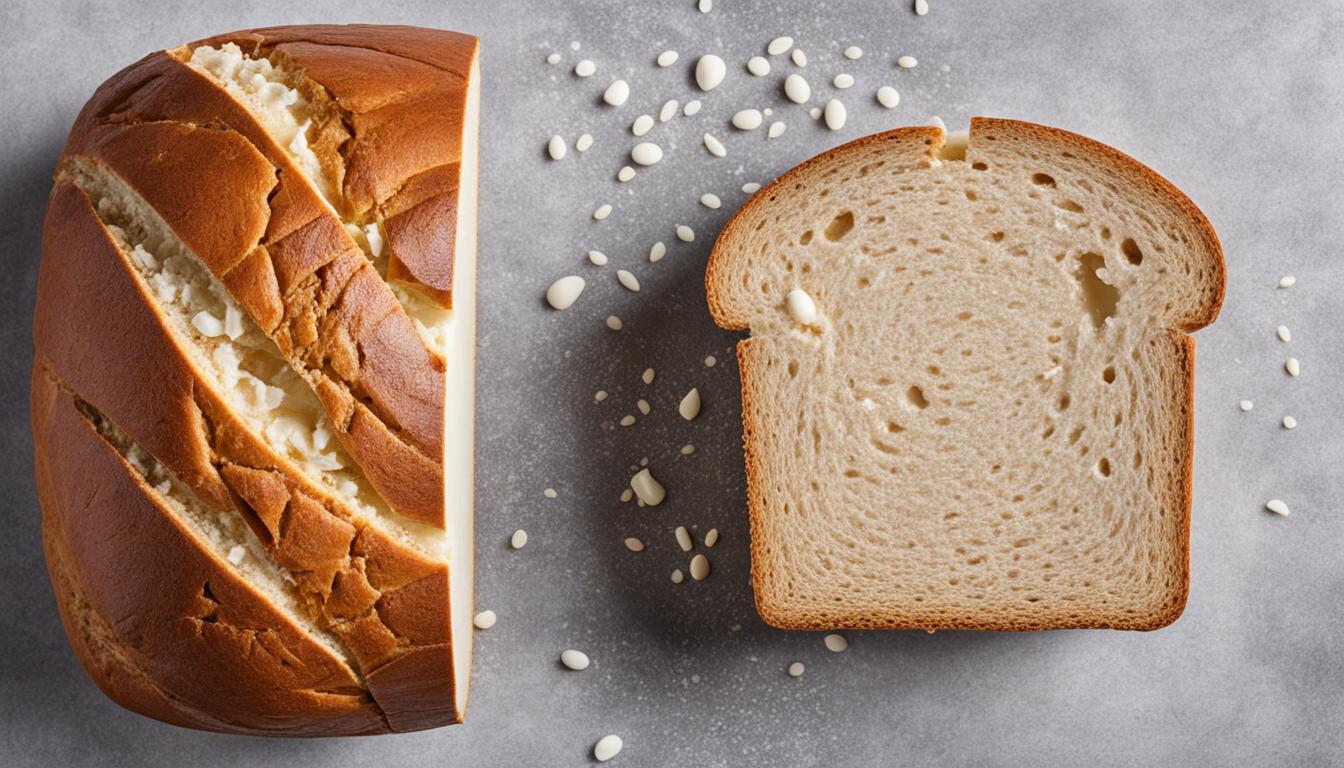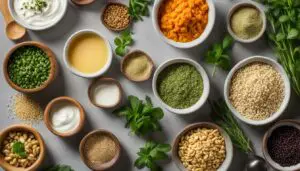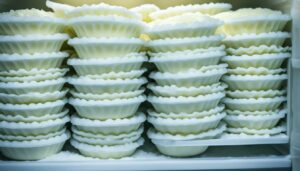Originally posted on January 9, 2024 @ 6:24 am
In most bread recipes, dry milk powder is used to add creaminess, tenderness, and flavor. However, if you don’t have dry milk or want to make a dairy-free bread, there are alternatives. You can substitute dry milk powder with water or non-dairy milk, such as almond milk, soy milk, or rice milk. Omitting the dry milk powder may make the bread slightly less tender and pale, but it can still be delicious. You can also replace butter with oil or vegan butter for a dairy-free option. There are options for substituting other dairy ingredients like buttermilk, sour cream, yogurt, and cream cheese as well. Just make sure to choose plain, unsweetened non-dairy alternatives. Overall, it is possible to omit dry milk from bread recipes without sacrificing flavor or texture.
Contents
- 1 The Role of Dry Milk in Bread Recipes
- 2 Substituting Dry Milk with Non-Dairy Milk
- 3 Omitting Dry Milk Powder
- 4 Substituting Butter with Oil or Vegan Butter
- 5 Alternatives for Other Dairy Ingredients in Bread Recipes
- 6 Using Tangzhong and High-Fat Non-Dairy Milk for Dairy-Free Bread
- 7 Conclusion
- 8 FAQ
- 8.1 Can I omit dry milk from a bread recipe?
- 8.2 What is the role of dry milk in bread recipes?
- 8.3 Can I substitute dry milk with non-dairy milk?
- 8.4 How do I omit dry milk powder from a bread recipe?
- 8.5 Can I substitute butter with oil or vegan butter in a bread recipe?
- 8.6 What are the alternatives for other dairy ingredients in bread recipes?
- 8.7 Can I use tangzhong and high-fat non-dairy milk for dairy-free bread?
- 8.8 What are the alternatives to dry milk in bread recipes?
- 9 Source Links
Key Takeaways:
- Dry milk powder enhances the flavor, texture, and rise of bread recipes.
- When omitting dry milk, you can substitute it with water or non-dairy milk.
- Replacing butter with oil or vegan butter provides a dairy-free option.
- Other dairy ingredients can be substituted with non-dairy alternatives.
- Experimenting with different non-dairy options can lead to satisfying dairy-free bread.
The Role of Dry Milk in Bread Recipes
Dry milk powder plays a crucial role in the creation of delicious and flavorful bread. Its addition enhances the texture, flavor, and rise of the bread, making it an important ingredient in many recipes. Here’s a closer look at the significance and benefits of using dry milk powder in baking bread:
| Importance of Dry Milk Powder in Baking Bread |
|---|
| Enhances Flavor |
| Dry milk powder adds a creamy and rich taste to the bread, significantly enhancing its overall flavor. |
| Improves Texture |
| The proteins and sugars present in dry milk powder contribute to a softer, more tender texture, resulting in a delightful eating experience. |
| Aids in Browning |
| The proteins in dry milk powder promote browning during the baking process, creating an appealing golden crust on the bread. |
| Enhances Rise |
| Dry milk powder provides additional nutrients and structure to the dough, resulting in a better and more reliable rise when combined with yeast. |
| Increases Shelf Life |
| By incorporating dry milk powder, the shelf life of baked goods is extended, allowing them to remain fresh for a longer duration. |
| Nutritional Benefits |
| Dry milk powder contains essential vitamins and minerals, adding nutritional value to the bread. |
While the benefits of using dry milk powder in bread recipes are numerous, there are alternative options available for individuals who cannot utilize this ingredient or prefer a dairy-free alternative. These substitutes can yield great results while still maintaining the desirable flavor and texture of the bread.
Now that we understand the role of dry milk powder in bread recipes, let’s explore some effective alternatives for those who cannot use dry milk or prefer a dairy-free baking option.
Substituting Dry Milk with Non-Dairy Milk
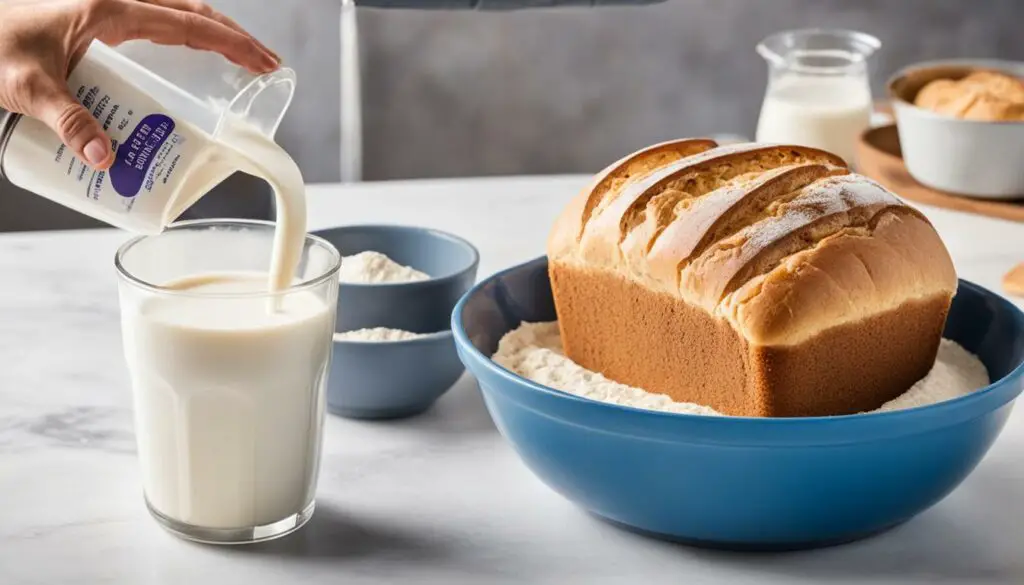
When a bread recipe calls for dry milk, you can easily substitute it with non-dairy milk. Options like almond milk, soy milk, and rice milk work well as they are neutral in flavor. These non-dairy milks can be used in a 1:1 ratio to replace regular milk. The choice of non-dairy milk depends on personal preference and dietary restrictions. It’s important to use unsweetened, unflavored varieties to maintain the desired flavor and texture in the bread. Some non-dairy milks, such as coconut and cashew milk, may impart a subtle nutty taste. Using non-dairy milk as a substitute for dry milk powder can result in dairy-free bread without compromising on taste.
Comparing Non-Dairy Milk Options for Substituting Dry Milk
| Non-Dairy Milk | Flavor Profile | Texture |
|---|---|---|
| Almond Milk | Neutral, slightly nutty | Light, thin |
| Soy Milk | Neutral, slightly creamy | Creamy, slightly thicker |
| Rice Milk | Neutral, mildly sweet | Thin, watery |
| Coconut Milk | Mildly nutty, tropical | Rich, creamy |
| Cashew Milk | Creamy, slightly sweet | Smooth, slightly thicker |
Each non-dairy milk option has its own unique flavor profile and texture. Almond milk and soy milk provide a neutral base, while rice milk adds a subtle sweetness. Coconut milk and cashew milk bring a delightful nuttiness and creaminess to the bread. Depending on your preferences, you can choose the non-dairy milk that best complements your recipe.
Omitting Dry Milk Powder
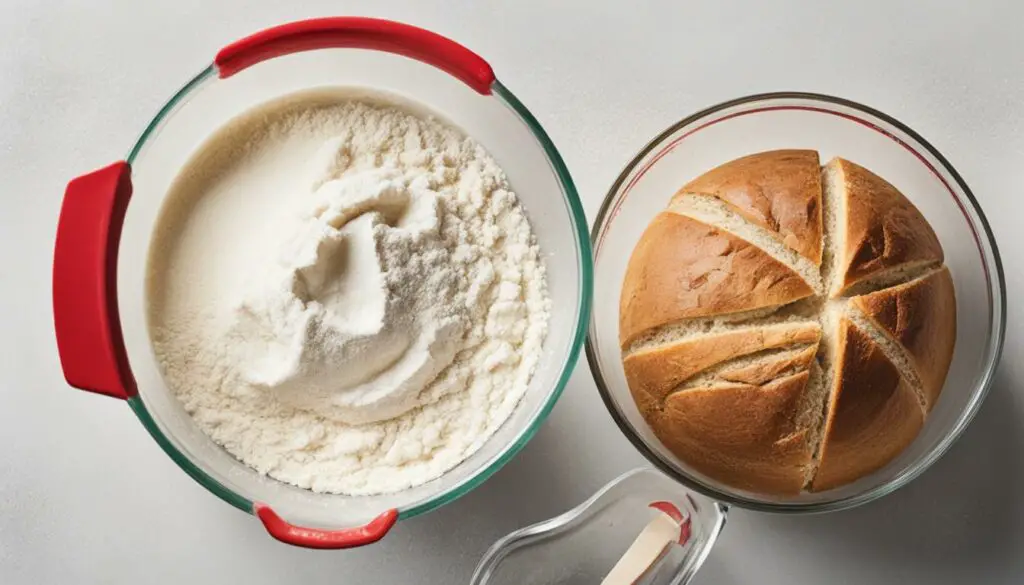
If you don’t have dry milk powder or prefer not to use it, there are options for omitting it from your bread recipe. One option is to simply omit the dry milk powder and use water instead. This may result in slightly less tender and paler bread. To compensate, you can extend the baking time by a few minutes to achieve a golden crust. Another option is to use non-dairy milk in place of water. By using plain, unsweetened non-dairy milk as a substitute for both water and dry milk powder, you can create a dairy-free loaf that closely resembles its dairy counterpart. This substitution can be made in a 1:1 ratio.
Table: Comparing the Use of Water vs. Non-Dairy Milk as Substitutes for Dry Milk Powder
| Ingredient | Water | Non-Dairy Milk |
|---|---|---|
| Texture | May result in slightly less tender bread | Can yield a similar texture to dairy-based bread |
| Color | Paler crust | Similar color to dairy-based bread |
| Flavor | No added flavor | No added flavor, unless the non-dairy milk has a distinctive taste |
By experimenting with these alternatives, you can create a delicious bread that suits your dietary preferences and needs.
Substituting Butter with Oil or Vegan Butter
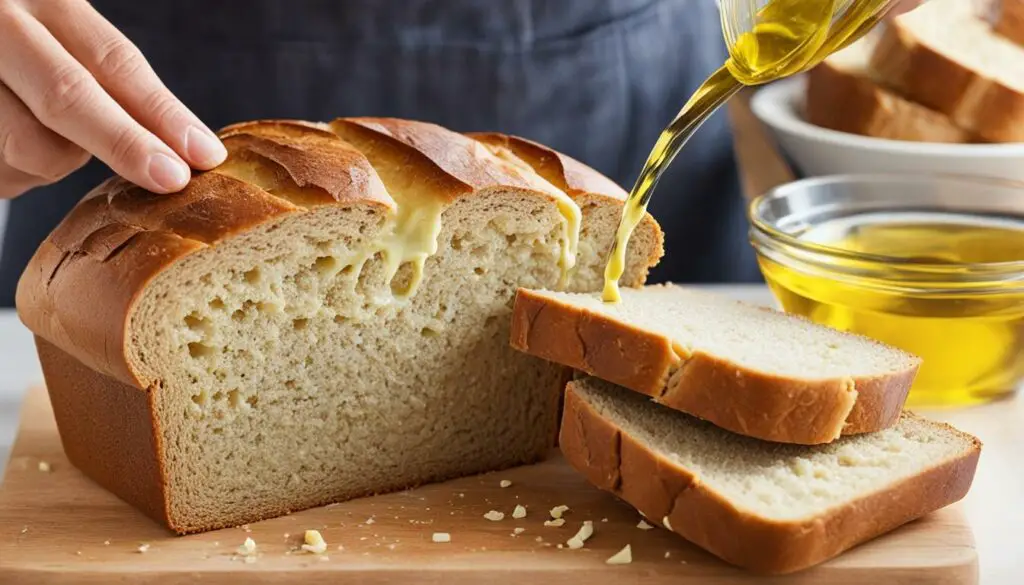
When making dairy-free bread, it’s essential to find suitable alternatives for butter. Fortunately, there are options available that will maintain the flavor and texture of your favorite bread recipes. Depending on the amount of butter required in the recipe, you can choose between using oil or vegan butter as a substitute.
If your bread recipe calls for a small amount of butter, such as a few tablespoons, vegetable oil can be used as an excellent replacement. Simply use an equal amount of vegetable oil instead of butter in the recipe. This substitution will not significantly impact the taste or texture of the bread.
However, for enriched doughs that require a larger amount of butter, like brioche or cinnamon rolls, it is recommended to use vegan butter. Vegan butter, such as Earth Balance Vegan Buttery Sticks, behaves similarly to regular butter in baking. It contains plant-based oils and emulsifiers that create a rich and buttery flavor in breads and pastries.
By substituting butter with oil or vegan butter, you can enjoy dairy-free bread that is just as delicious as its traditional counterpart.
Below is a table summarizing the substitution options for butter in bread recipes:
| Bread Recipe | Amount of Butter | Substitution |
|---|---|---|
| Bread with a small amount of butter | A few tablespoons | Equal amount of vegetable oil |
| Brioche or cinnamon rolls | A larger amount of butter | Vegan butter, such as Earth Balance Vegan Buttery Sticks |
Using the appropriate substitution method, you can create dairy-free bread that is flavorful, moist, and satisfying.
Alternatives for Other Dairy Ingredients in Bread Recipes
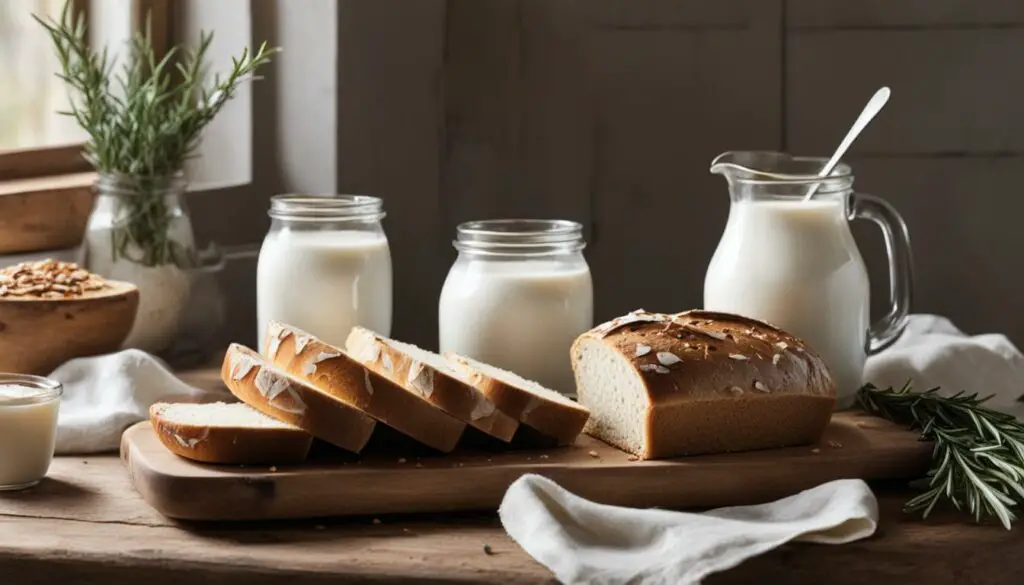
Many bread recipes call for dairy ingredients like buttermilk, sour cream, yogurt, or cream cheese to add flavor and texture. However, if you’re looking to make a dairy-free bread, don’t worry! There are plenty of non-dairy alternatives available that can still give you delicious results.
Substitutes for Buttermilk
If a recipe calls for buttermilk, you can easily make your own dairy-free version. Simply add 1 tablespoon of lemon juice or vinegar to 1 cup of plain, unsweetened non-dairy milk. Let it sit for a few minutes until it curdles slightly, and then use it as a substitute for buttermilk in your bread recipe with confidence.
Alternatives to Sour Cream
Sour cream can be replaced with non-dairy options that provide a similar tanginess. Soy milk, in particular, tends to have a slightly tangy flavor that makes it a great substitute for sour cream in bread recipes. Just make sure to choose plain, unsweetened soy milk for the best results.
Non-Dairy Yogurt in Bread Recipes
Another versatile dairy alternative for bread recipes is non-dairy yogurt. Plain, unsweetened soy, almond, or coconut yogurt can all be used in place of regular dairy yogurt and sour cream. The key is to select a non-dairy yogurt that matches the desired flavor profile of your bread recipe. Remember to adjust the liquid in the recipe as needed, since non-dairy yogurt may have a slightly different consistency.
For a complete list of dairy ingredient alternatives, refer to the table below:
| Dairy Ingredient | Non-Dairy Alternative |
|---|---|
| Buttermilk | Lemon juice or vinegar mixed with plain, unsweetened non-dairy milk |
| Sour Cream | Plain, unsweetened non-dairy yogurt or soy milk |
| Yogurt | Plain, unsweetened non-dairy yogurt (soy, almond, or coconut) |
| Cream Cheese | Non-dairy cream cheese alternative (if available) |
Experimenting with these dairy ingredient alternatives will give you the freedom to enjoy dairy-free bread that suits your dietary needs and preferences. Don’t be afraid to get creative and try different non-dairy options to find your favorite combinations. With these substitutes, you can enjoy delicious bread without compromising on flavor or texture.
Using Tangzhong and High-Fat Non-Dairy Milk for Dairy-Free Bread
Some bread recipes, like Japanese milk bread or soft cinnamon rolls, use a technique called tangzhong to create extra light and tender dough. Tangzhong involves making a roux-like mixture by cooking flour and water, which is then added to the bread dough. This method helps to retain moisture, improve the bread’s texture, and prolong its freshness.
To make dairy-free bread using tangzhong, you can substitute regular milk and dry milk powder with high-fat non-dairy milk. Coconut milk, specifically the kind that comes in a box or carton (not canned), is recommended for its high fat content. Using coconut milk or another high-fat non-dairy milk in place of regular milk and water can yield delightful results in dairy-free bread.
The tangzhong method creates bread with a soft, fluffy texture and a slightly sweet flavor. By using high-fat non-dairy milk, you can achieve similar results while keeping your bread dairy-free. The fat content in the milk adds richness and moistness to the bread, making it a delicious alternative for those who are lactose-intolerant or following a dairy-free diet.
If you decide to use coconut milk, be aware that it may impart a subtle coconut flavor to the bread. However, this can be an enjoyable addition, especially when making tropical-flavored bread or desserts.
By using tangzhong and high-fat non-dairy milk, you can create dairy-free bread with a light, tender crumb and a delicious flavor. Enjoy the benefits of this technique while accommodating your dietary preferences or restrictions.
Conclusion
Omitting dry milk from a bread recipe is possible and can be done without sacrificing flavor or texture. By using non-dairy milk, skipping the dry milk powder, and making substitutions for butter and other dairy ingredients, you can create delicious dairy-free bread. It’s important to choose unsweetened, unflavored non-dairy milk and yogurt, and to adjust the liquid in the recipe if necessary. Experimenting with different non-dairy options and finding the ones that suit your taste preferences and dietary needs can result in satisfying dairy-free bread. Whether you’re lactose-intolerant, have dietary restrictions, or simply want to try a dairy-free option, there are alternatives available that can provide equally fantastic results. Enjoy your dairy-free baking adventures!
FAQ
Can I omit dry milk from a bread recipe?
Yes, you can omit dry milk from a bread recipe. There are alternatives that can still yield great results.
What is the role of dry milk in bread recipes?
Dry milk powder adds creaminess, tenderness, and richness to the dough. It also helps with browning, improves the structure of yeast breads, and increases the shelf life of baked goods.
Can I substitute dry milk with non-dairy milk?
Yes, you can substitute dry milk with non-dairy milk like almond milk, soy milk, or rice milk. They can be used in a 1:1 ratio to replace regular milk.
How do I omit dry milk powder from a bread recipe?
You can omit dry milk powder and use water instead. Another option is to use non-dairy milk as a substitute for both water and dry milk powder in a 1:1 ratio.
Can I substitute butter with oil or vegan butter in a bread recipe?
Yes, if the recipe calls for a small amount of butter, you can use an equal amount of vegetable oil. For larger amounts of butter, it’s recommended to use vegan butter, such as Earth Balance Vegan Buttery Sticks.
What are the alternatives for other dairy ingredients in bread recipes?
You can make your own buttermilk by adding lemon juice or vinegar to non-dairy milk. Non-dairy yogurt can replace sour cream and regular yogurt. There are also non-dairy cream cheese options available.
Can I use tangzhong and high-fat non-dairy milk for dairy-free bread?
Yes, you can use high-fat non-dairy milk, like coconut milk, to create dairy-free bread using the tangzhong method. It can yield light and tender dough.
What are the alternatives to dry milk in bread recipes?
By using non-dairy milk, skipping dry milk powder, and making substitutions for butter and other dairy ingredients, you can create delicious dairy-free bread. Experiment with different non-dairy options to suit your taste and dietary needs.

